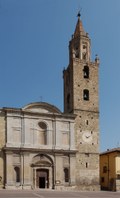Church of Saint Mary in Platea
The Church of Saint Mary in Platea is in Piazza Farnese, Campli’s main square. It was built in the late 14th century on the ruins of an older building. Already in 1395, just after its construction, it became a Collegiate church, a boarding school for priests. The church’s influence increased in 1764, after an outbreak of typhus fever, when Campli sought the protection of the Immaculate Conception, proclaiming her queen and patroness saint of the town and the surrounding area.
During the 18th century, the church underwent a renovation work that radically changed its look. In fact, the façade’s central part, in neoclassic style, was the result of the work, which, to be precise, took place in 1793. The niche above the portal is adorned with a sculpture of Madonna with Child, perhaps by Gagliardelli.
Evidence of the several works carried out in the church are visible in the bell tower erected in the 14th century, by using stone and tufa blocks. The building structure, otherwise heavy and chunky, became lighter by adding single and double lancet windows.
The quadrangular structure of the base of the tower suddenly changes into an octagonal one in the upper part of the building. Antonio da Lodi perhaps decorated this section in 1474, by using painted ceramic tiles.
During the renovation works of 1793, the bell tower was extended upward by building an octagonal cusp. Towards the end of the last century, it underwent further renovation works, mostly in its upper part, and these changed the outer look.
Although originally built as a one-nave church today’s Saint Mary has a three-nave plan ground: the aisle on the left was built between the 15th and 16th century; the one on the right was completed in 1561 according to the records of the time. The magnificent ceiling of the nave is breathtaking. Made in wood, it was decorated with paintings by artists from the Roman School, in part realized directly on the planks, in part on canvasses.
Most of the artworks preserved in the church were moved to the Diocesan Museum still under construction. In the aisle on the right there was a painted wooden cross of the 14th century; a copy of the Visitation of the Virgin by Raffaello, probably made by a follower of his school; a Madonna with Child of 1577 by the master Giovanni Battista Ragazzini. In the aisle on the left, there is the stony altar of the Holy Sacrament of 1532, realized by Sebastiano da Como. On this altar used to be kept the gilt, painted wood Madonna with Child of 1495, attributed to Giovanni da Biasiuccio. On either side of the wooden statue there were two paintings by Cola d’Amatrice, representing St John the Baptist and the Ursuline sisters and Catherine of Siena, Saints Gregory, Sebastian and Paul. The church owns many others valuable artworks: canvasses, frescos and altars and above all the wood panel of the Madonna Enthroned nursing Infant Jesus attributed to Giacomo da Campli.

















